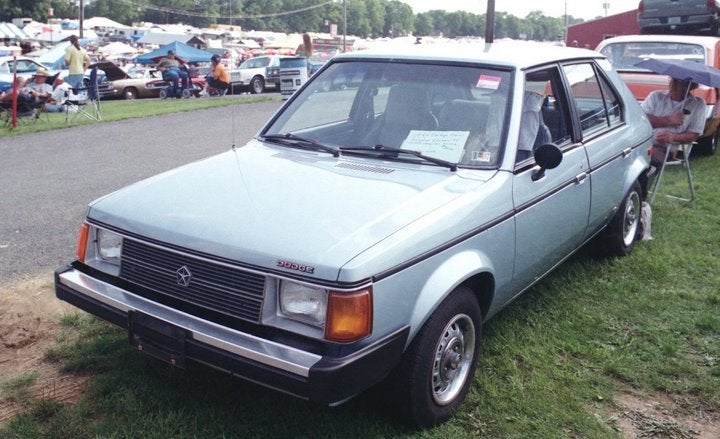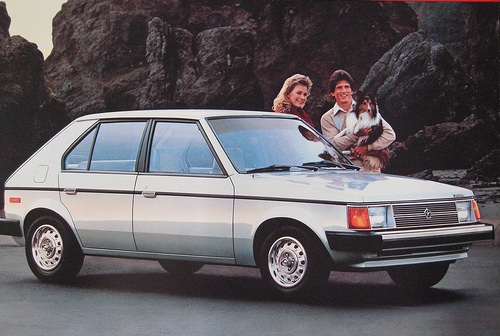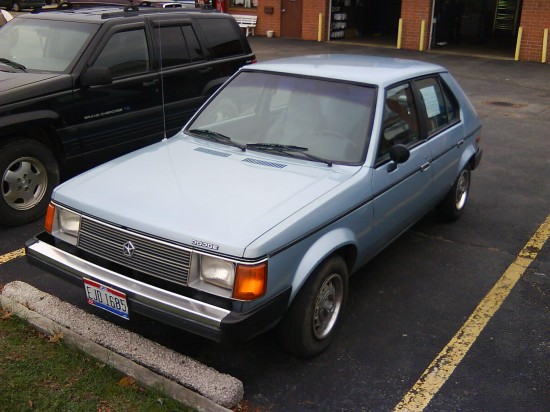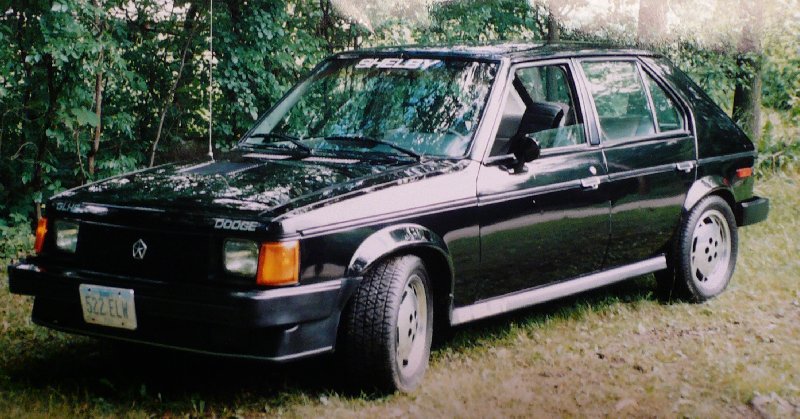Dodge Omni

The Omni/Horizon was designed by Chrysler Europe (a merger of Simca and Rootes Group). The Omni and Horizon were the first North American mass-produced cars with a transverse mounted engine, and the first front-drive subcompact four-door hatchbacks made in America; they were also the first front wheel drive Chryslers, and the first to use a semi-independent rear suspension, with trailing arms and coil springs. The construction was unibody, with an independent iso-strut coil-spring front suspension.
In 1990, there was a 1" diameter front stabilizer bar, with no rear stabilizer bar. Rack and pinion steering was available in both manual and power versions. Base wheels in 1990 were 13 inches, not unusual for the day, with ride-oriented P165/80 tires softening the stiff suspension.
In Europe, Chrysler and Talbot Horizons used Simca engines, in 1.1, 1.3, and 1.4 liter sizes through their full lifespan.
The Omni/Horizon were internally labelled L-bodies (A included Valiant and Duster, B included Belvedere and Charger, C included big Chryslers, E was Challenger/Barracuda, etc.) [This section written by Allpar staff]
History of the Dodge Omni and Plymouth Horizon

The first front-wheel-drive subcompact car ever to be built in America hits the showroom...the Dodge Omni and Plymouth Horizon. [Webmaster notes:] Based on the Horizon of Chrysler Europe, [End note]the Omni/Horizon would help to save the corporation from bankruptcy. For once, Chrysler displayed a product that was right for the times.
The stunning success of the Horizon didn’t surprise Burton Bouwkamp, one of its creators. He wrote, “We knew it was a great car and attractively priced. It ran eleven years with very few changes. We must have built around 2,500,000 Omnis and Horizons. It's still a good car. If we had modernized and improved it I think it would still be around.”
The Omni and Horizon were in production between 1978 through 1990. Throughout the eighties, Omnis never sold even nearly as well as the Horizon did. In 1979, a sunroof became available for both models. In 1981, a new 2.2-liter 84 horsepower 4-cylinder became available and the term "Miser" was mentioned for the basic model with 1.7 engine, presumably to compete with the new, cheap Ford Escort. Throughout 1981 and 1982, an extremely limited number of Euro-models were offered with blackout trim in the package. The Custom package replaced the Miser and Euro models.
For 1981, electric-fan airflow was improved with a fiberglass-filled propylene fan, with a 1 inch larger diameter; the radiator was enlarged in frontal area and thickness.
For 1982, a linkless sway bar was used: this essentially used rubber isolators to hold the sway bar to the lower control arm and crossmember. Chrysler claimed this reduced body roll when cornering, and made the ride more comfortable.

In 1984, an SE (sport-edition) model was created with two-tone coloring available, and the basic styling that would continue until 1990 was put into place. The instrument cluster was revised, and blackwalls became standard. Most significantly, 1984 brought the new Omni GLH — for "Goes-Like-Hell." This lightweight Dodge Omni had the 2.2 liter engine with turbocharged power. Omni GLH and GHL-S page.
For 1984, the Horizon was aimed at domestic buyers looking for a small-but-not-too-small car, and import buyers. It arguably offered the best value for the money, with a good level of performance, gas mileage, and interior space. The Horizon, even in base model (with "blackout" exterior), was more than entry-level transportation. New features included a five-speed stick, 165/50R13 tires standard, various cosmetic changes inside and out (with new gauge cluster), Rallye instrument panel option with full gauge cluster, new seats, and four-spoke steering wheel. A "Shelby" version of the 2.2 was available with 110 hp.
The 2.2 liter engine made the Omni and Horizon quick, but still turned out 26 mpg city, 36 mpg highway (with manual transmission). The base 1.6 engine beat that with 31/39. Radio options were similar to the brands’ top of the line cars; electronic spark and fuel control were standard. Base models had a speedometer, voltmeter, and fuel gauges, with dummy lights for other functions, but an optional instrument panel was identical to the attractive, high-end design used on Turismo. In a break with the past, the wipers/washers were on a stalk.
1989 brings some changes to the engine which allow for quieter and smoother running. Major service pointers were highlighted with paint for checking fluid levels.

Комментариев нет:
Отправить комментарий